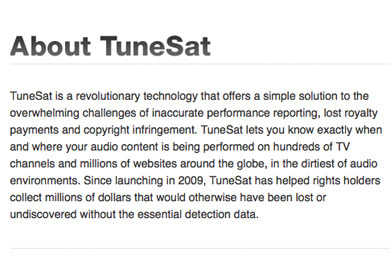
 TuneSat is a service provider that monitors television and internet sites for copyright usage using fingerprint technology. It provides near real-time reporting to content owners showing all performances that were detected with the date, time, channel, show, episode, composition, duration of time played, as well as, the recording of the captured performance as proof positive of the use. For internet usage, TuneSat reports the website, the hosting site, and contact information. TuneSat also provides reports comparing detected performance with royalty statements showing variances between the two.
TuneSat is a service provider that monitors television and internet sites for copyright usage using fingerprint technology. It provides near real-time reporting to content owners showing all performances that were detected with the date, time, channel, show, episode, composition, duration of time played, as well as, the recording of the captured performance as proof positive of the use. For internet usage, TuneSat reports the website, the hosting site, and contact information. TuneSat also provides reports comparing detected performance with royalty statements showing variances between the two.
MusicRow recently sat down exclusively with Chris Woods, Executive Vice President and Chief Operations Officer of TuneSat for a candid discussion about this innovative company and the services offered from its audio fingerprinting technology. Woods, a graduate of the Berklee School of Music, has created music branding packages for numerous television networks, including Fox Sports, Versus and Big Ten. As a music composer himself, Woods knows first-hand the challenges of music royalty licensing and collection issues which led him to co-found TuneSat in 2007.
MusicRow: The royalty payment process requires the licensee to obtain a license in order to report all the music they use to the PROs (Performance Rights Organizations) which then triggers the royalty payment. What led you to that moment where you believed you had something to offer?
Woods: We conducted case studies over a decade with majors, indies, and small composers like myself to compare detected performance data on television to performance royalties and found empirically that between 60 and up to 80% of music on television is never reported to the societies. In this day and age, technology has the ability to resolve this issue. We decided to start a service for all content owners to be able to know exactly when and where their music is playing.
MusicRow: What was the first step in offering such a service?
Woods: We established a monitoring facility and secured our own technology to constantly listen to 109 national network broadcasters in the US for performances of our clients master recordings in our fingerprint database.
MusicRow: What is the biggest issue with a content owner identifying usage of the copyright?
Woods: The problem with television and other technologies is you have to be able to identify music when it’s buried under dialogue, sounds affect, crowd noise, etc.. We can identify any 3 seconds of a broadcast to make a positive identification with the master recording.
MusicRow: What advice to you give content owners regarding being a curator of their copyrights?
Woods: You have to be business minded. You have to understand what your rights are, understand where the money comes from and keep track of it. We see ourselves as a tool that music rights owners can use to help them track down that money.
MusicRow: Where does the Nashville music industry fit into the strategic initiatives of TuneSat?
Woods: One of our main initiatives is to get to the songwriter community and let them know we exist and how we can help them. Nashville is a great market for us and one we are heavily pursuing. A lot of the initiatives for us are to be more part of the Nashville organizations and embrace the different societies here. We really want to work with everyone to understand what the challenges are and how we can help monetize their music.
MusicRow: With the sheer expansiveness of the internet, is it something you can actually monitor?
Woods: Everyone knows their music is misused on the internet but finding it, resolving it, dealing with it– it’s a complete mess. Our answer to that is, “yes you can monitor the internet,” and we’re going to do in a way that no one else can. We are monitoring millions of websites around the world for the use of our clients music regardless of whether it’s a hotel website in Italy or a real estate website in Switzerland. We are going to find the music, detect it, and provide our clients with that information.
MusicRow: Do you see where your service has been successful?
Woods: We’ve recovered millions of dollars on behalf of our clients that have used our information.
Subscribers can sign up online and can choose monitoring of television, internet or both. Customers include record labels, publishers, and individual memberships. Rates are based on amount of content and start at $10 per month for monitoring of up to 10 songs. In the event of a royalty discrepancy, TuneSat subscribers can pursue the claim themselves, or hire the company’s newly-launched Administrative Services branch to pursue unlicensed and unpaid uses of their music.
For more information, visit www.tunesat.com.

Category: Exclusive, Featured, Financial/Legal, Organizations
About the Author
Sherod Robertson is President and Owner of MusicRow Enterprises. He oversees all operations and develops strategic initiatives for MusicRow magazine, RowFax, and MusicRow's CountryBreakout chart. Robertson previously served as Director of Finance of Arista Records after beginning his career as Vice President of Finance and CFO at Reunion Records.View Author Profile



